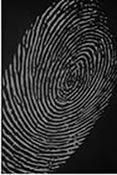
Latent Fingerprints
Home > I. Types of Evidence > Latent Fingerprints
Special attention must be paid to items that will be processed for latent fingerprints. These must be packaged and handled in a way that prevents the deposit of additional latent fingerprints or smearing of latent evidence prints before visualization. 
When latent prints or palm prints, etc., are present, they may be examined for the presence of touch DNA. The destructive nature of certain processing techniques needs to be considered before a decision can be made as to whether to swab for DNA or collect the latent print. The quantity and quality of other sources of DNA evidence that may also be present at the scene should be considered in a discussion with the investigator or laboratory personnel.
In addition, there are some cases where discussion with laboratory personnel is advised to determine the sequence of examinations. For example, an aluminum can may be submitted to the laboratory with a request for latent fingerprint and DNA analysis. Some latent print visualization and processing techniques can cause loss or damage to DNA evidence. In the reverse, the DNA analysis process may eliminate latent fingerprint evidence.



